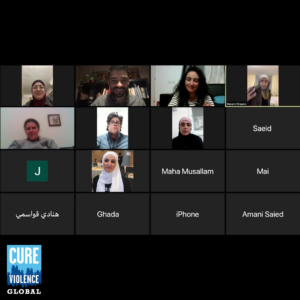As part of Cure Violence Global’s efforts to reduce violence on an international scale, CVG’s MENA Program Officer Mohammed Alshurafa and the West Bank Project Coordinator Amal Hadweh conducted a 10-day online training in the West Bank. Twenty women community activists participated from multiple cities, including Jerusalem, Ramallah, Bethlehem, Hebron, and Nablus. The training aimed to build the participants’ knowledge on Cure Violence’s health approach to violence reduction and violence prevention, raise their understanding about the spread of COVID-19 and the risks it poses, build their non-violent communication capacity, and provide them with techniques for coping with loss and stress.
 In recent years, CVG has implemented its approach in active conflict areas including Syria and Iraq with documented results in decreasing violent acts in those communities. In the Palestinian context, CVG conduct trainings in Bethlehem, Hebron, Jerusalem, and Nablus in 2016-2017 in partnership with the Salam Institute in Washington, DC. That series of trainings created an initial network of 25 volunteers trained in the CVG public health approach and the skills necessary to mediate conflicts, map and detect violence, and change social norms related to violence.
In recent years, CVG has implemented its approach in active conflict areas including Syria and Iraq with documented results in decreasing violent acts in those communities. In the Palestinian context, CVG conduct trainings in Bethlehem, Hebron, Jerusalem, and Nablus in 2016-2017 in partnership with the Salam Institute in Washington, DC. That series of trainings created an initial network of 25 volunteers trained in the CVG public health approach and the skills necessary to mediate conflicts, map and detect violence, and change social norms related to violence.
A New Understanding of Conflict and Violence
The recent training began by providing the participants with an updated understanding based on CVG’s health approach. Through the following activities, participants were trained on how to deal with conflict and violence from health perspective:
• Participants worked in groups to analyze the local conflicts in their community, the people involved, what usually ignites the conflicts, how it has been deescalated in the past, whether the usual de-escalation methods are effective, and how they can be improved.
• Participants created role plays based on actual past violent incidents in their communities, which helped them gain a better understanding of the dynamics of violence.
• They also became aware of the dangerous effects of toxic stress on the brain, and how constant exposure to stress and violence in the absence of protective factors leads individuals to become more violent.
• Participants learned strategies for violence reduction based on the time of an intervention (before the violent event, in the midst of the event, and after the event).
• Together, participants mapped the norms/attitudes that support and justify violence in their communities and started developing messages to mitigate these attitudes.
• Participants started developing public education messages to reduce existing risk factors and to strengthen protective factors in order to limit the spread of violence in their communities.
Curing COVID-19 in the West Bank
The participants were trained on two COVID-19 modules. In the first module, they received a general background about the COVID-19 virus, how it spreads, and how to prevent the spread. The training leaders initiated discussions concerning day-to-day issues regarding social distancing. For example, one discussion helped the participants think about ways to avoid handshaking during the pandemic; a handshake has sensitive cultural importance in the Palestinian culture, especially for elderly people in some areas. The participants will carry these ideas and turn them into Public Education messages on social media. In the second module, the participants were trained on how to deal with loss, cope with stress, and the trauma of COVID-19. They also received helpful resources in the forms of mobile apps, YouTube channels, and social media pages.
Nonviolent Communication (NVC) Skills for Healthy Relationships
In the second phase of the training, CVG’s West Bank project coordinator Amal Hadweh led the sessions on Nonviolent Communication (NVC) training. The training started with an NVC ice-breaking activity and trust-building, followed by defining NVC and building the model’s theoretical base. Then, the participants were trained on the four steps of NVC (observations, feelings, needs, and requests). Some parts of the training were designed for the participants to join with their family members and practice nonviolent communication skills. Lastly, the participants were trained on compassionate listening and empathic listening skills.
“One of the most wonderful experiences in my life, we communicated well (me and my child) we spend the whole day looking at each other faces and smile. I learned to express my feelings to my child. I was worried always about him and his future. But now I can communicate with him and express my worries in nonviolent manner.” -One participant
A major finding of the training was that the understanding of violence as a learned and contagious behavior had increased, and people who disagreed on these concepts before the training changed their perception after completing the training. In addition, the health approach training convinced the participants that violence can be prevented – even in the Palestinian context.
As next steps, the trained Palestinian community activists will work together to 1) develop and implement public education campaigns that aim to raise the understanding of violence as a health issue; 2) target specific types of violence in their communities such as gender-based violence, domestic violence, and child abuse; 3) develop messaging to reduce and prevent these forms of violence; and 4) work on raising the community’s understanding of the spread of COVID-19 and the risks it poses.
Palestinian women as catalyst for peace
The active and committed participation of Palestinian women during the training showcases the key role that Palestinian women play in mitigating and preventing conflicts and violence, as well as other facets of public life.
In the light of International Women’s Day on March 8th, CVG recognizes women in the West Bank as contributors to the global movement of Women Peace and Security recognized in the United Nations Security Council Resolution 1325. The resolution is relevant to the Palestinian context, as it calls for the full protection of women during and after an armed conflict, as well as the prevention of and recovery from violence and other conflict-related gendered impacts. Cure Violence’s project in the West Bank is not only an example of mainstreaming gender diversity in violence prevention, but also a catalyst for further peaceful contributions and partnerships among women.


